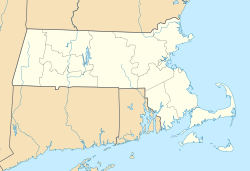Timothy Hartshorn House | |
 | |
| Location | 379 Haverhill Street, Reading, Massachusetts |
|---|---|
| Coordinates | 42°32′35″N71°5′22″W / 42.54306°N 71.08944°W |
| Built | 1787 |
| Architectural style | Federal |
| MPS | Reading MRA |
| NRHP reference No. | 84002633 [1] |
| Added to NRHP | July 19, 1984 |
The Timothy Hartshorn House is a historic house in Reading, Massachusetts. This 2+1⁄2-story wood-frame house was built c. 1787 by Timothy Hartshorn, a farmer and shoemaker, and remained in his family for over 100 years. It is a vernacular Georgian-Federal style, with five bays and a central chimney. The main entrance is flanked by sidelight windows and fluted pilasters, supporting an entablature with high capitals, but is somewhat obscured by the 19th century porch. [2]
The house was listed on the National Register of Historic Places in 1984. [1]


